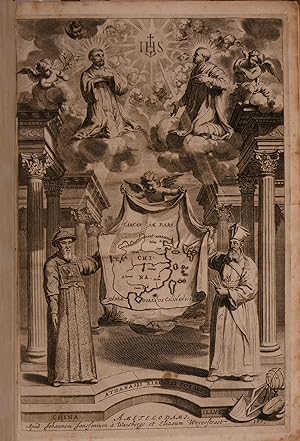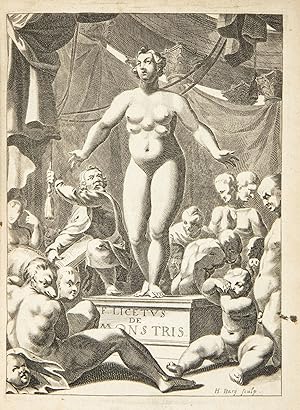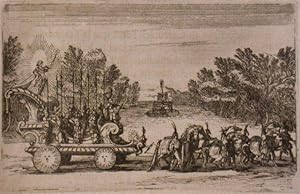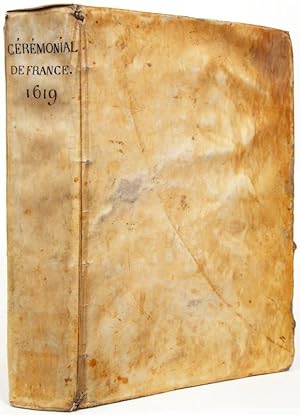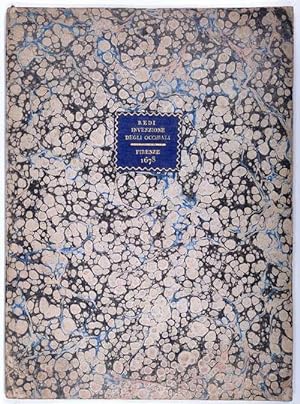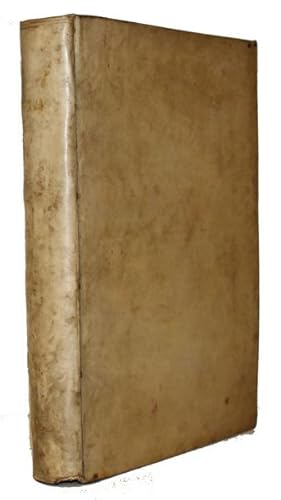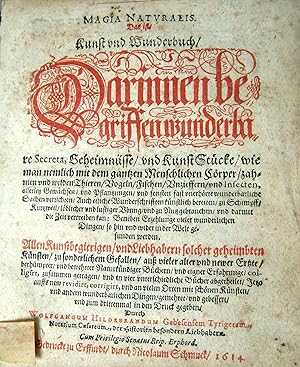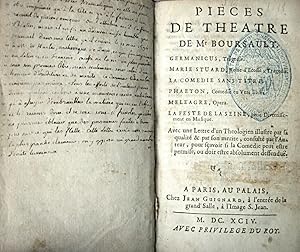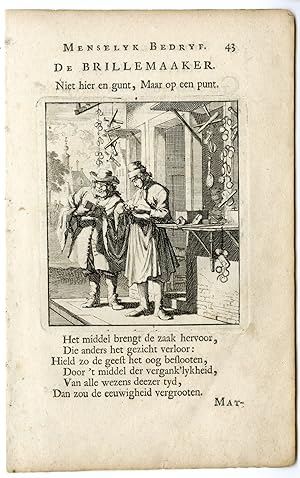art spectacle (18 résultats)
Type d'article
- Tous les types d'articles
- Livres (17)
- Magazines & Périodiques
- Bandes dessinées
- Partitions de musique
- Art, Affiches et Gravures (1)
- Photographies
- Cartes
-
Manuscrits &
Papiers anciens
Etat
Reliure
Particularités
- Edition originale (9)
- Signé
- Jaquette
- Avec images (16)
- Sans impression à la demande
Livraison gratuite
Pays
Evaluation du vendeur
-
Le nozze degli dei favola Dell' Ab' Gio. Carlo Coppola Rappresentata in Musica in Firenze nelle reali nozze De Serenis.mi Gran Duchi di Toschana Ferdinando II. e Vittoria Principessa d'Urbino BOUND WITH Relazione delle nozze degli dei favola dell'Abate Gio: Carlo Coppola Rappresentata nelle reali Nozze de'Sereniss. Gran Duchi di Toscana Ferdinando II. E Vittoria Principessa d'Vrbino. Alla Medesima Gran Dvchessa di Toscana
Edité par Amadore Massi and Lorenzo Landi, Florence, 1637
Vendeur : Arader Books, New York, NY, Etats-Unis
Edition originale
Softcover. Etat : Very good. First. First editions. Florence: Amadore Massi and Lorenzo Landi, 1637. Quarto (9 5/8" x 6 3/4", 236mm x 172mm). [Full collation available.] With an engraved title-page integral to the text, and 7 folding engraved plates by Stefano della Bella after designs of Alfonso Parigi. Bound in contemporary limp laced vellum. Author and title ink manuscript to the spine. Soiling to the edges of the binding, with some loss to the front upper fore-corner. Text-block loose although not precarious, split at H1. A little worming to the paste-downs and to the first free end-paper, not affecting text. F4 laid in, and a dampstain to the lower fore-corner of 2E-F2. A totally unsophisticated copy, with the long stubs of the plates. With the bookplate of Paul and Marianne Gourary (from their sale) on the front paste-down. (Ownership?) signature twice of "Sig.r Gio(rgio) Pavoli" on the verso of the final free end-paper. Ferdinando II de' Medici (1610-1670) became Grand Duke of Tuscany at the age of 10, and his mother and grandmother served as his regents and matchmakers. They arranged a marriage in 1634 to his first cousin, Vittoria della Rovere, granddaughter of the last Duke of Urbino. The aim of the union was to merge the Duchy of Urbino into that of Tuscany, but the gambit ultimately failed; Urbino was absorbed by the Papal States. The products of the marriage, therefore, were their two children who lived to adulthood and the account of the splendid wedding celebrations. As befitted the union of two of Italy's great noble families, the wedding was a multi-day spectacle at the Palazzo Pitti. In these early days of opera, the totality of the art-form (Wagner's Gesamtkunstwerk) was perfectly suited to these grand occasions. Giovanni Carlo Coppola (1599-1651) was the librettist of a tale (favola) of the marriage of the gods Venus and Vulcan (which was perhaps prescient; Venus cheated on her husband with Mars; conversely, Vittoria is said to have found her husband in bed with his pageboy), Jupiter and Juno (in heaven), Neptune and Amphitrite (in the sea) and Pluto and Proserpino (in the underworld). The music was overseen by Marco da Gagliano, maestro di capella of the Medici court, but there were in fact five composers commissioned to contribute (p. 27), with Ferdinando Saracinelli conducting. Agnolo Ricci was choreographer of the several balli bracketing the drama, and Alfonso Parigi designed the sets (including the elaborate stage machines). These sets are reproduced in the folding plates, and give a sense of the grandeur of the production. Coppola's libretto is the first portion of the work, and the second part is a description, attributed to Rondinelli, of the production as a whole, a surpassingly rare account of early operatic stagecraft. We learn, for instance, that there were around 150 singers and at least 25 dancers in the production. In addition, this appears to be the earliest recorded usage of the word "opera" to mean a musical drama, rather than "works," which is its literal translation; the Oxford English Dictionary places the earliest usage in this sense two years later in 1639. Most intriguing is the double signature to the verso of the final free end-paper of Giorgio Pavoli, who was gonfaloniere (mayor) of Livorno, the great port of Tuscany, in 1631. Ferdinando II oversaw a major modernization of the city from 1629, and in the year of Pavoli's mayoralty the Chiesa di Sant'Anna was opened, doubtless a major event. It is possible that Pavoli was invited to the wedding, and bought the book three years later as a souvenir. Centuries later, the present item joined the great collection of "fête books," as they are known, amassed by Paul (principally) and Marianne Gourary. After Paul's death in 2007, the collection -- "Splendid Ceremonies" -- was sold by Christie's New York (12 June 2009), in which the present item was lot 512. Berlin Ornamentstichsammlung 4116; Brunet II.262; Nagler, Theater Festivals of the Medici, pp. 162-174; Watanabe 1285.
-
5 tomes en 3 volumes in-folio manuscrits de (3)-242 ff. ; (1)-213-(2)-(2)-171 ff. ; (2)-183-(3)-140 ff., tables, veau brun, dos orné à nerfs, tranches jaspées (reliure de l'époque). Superbe manuscrit calligraphié du cérémonial de Nicolas de Sainctot couvrant la période 1660-1684 en cinq parties : 1660-1665, 1666-1671, 1672-1677, 1679-1681, 1682-1684.Nicolas Sainctot (vers 1632-1713) fut pourvu de la charge de maître des cérémonies le 18 janvier 1655 ; le 23 août 1691, il vendit sa charge à Desgranges et acheta une moitié de celle d'introducteur des ambassadeurs. Il se démit de cette dernière le 9 décembre 1709 au profit de son deuxième fils Nicolas-Sixte dit le chevalier de Sainctot.Description des cérémonies extraordinaires, relations de lits de justices, baptêmes, bénédictions, fiançailles, enterrements, pompes funèbres, Te Deum, élections des prévôts, audiences aux députés et ambassadeurs, prestation de serment des échevins - ce recueil s'inscrit dans le prolongement du Cérémonial françois de Godefroy, « dont il constitue en quelque sorte l'application pratique, adaptée au cadre versaillais et aux usages du règne de Louis XIV » (Alexandre Maral, La chapelle royale de Versailles sous Louis XIV: cérémonial, liturgie et musique).C'est durant ce règne que « le cérémonial passe au premier plan, et il exprime tout le système de conventions définissant l'autorité publique. Régler l'ordonnance des cérémonies royales devient l'affaire de professionnels, le grand maître des cérémonies, le maître et l'aide aux cérémonies. Les documents laissés par Nicolas Sainctot illustrent le formidable développement de cet office. Les maîtres de cérémonies reçoivent les ordres du roi pour le Lit de justice, distribuent les convocations, dressent des plans précis de la disposition des sièges, règlent le déroulement de l'assemblée, conservent un compte rendu des séances en un lieu nouvellement prévu à cet effet et soumettent au roi à sa demande des mémoires sur le protocole » (Sarah Hanley Madden, L'idéologie constitutionnelle en France : le lit de justice. 1982).Très beau document qui reprend une partie des quatre volumes du manuscrit original conservés à la B.N.F. sous les références Ms français 14117 à 14120.Catalogue général des manuscrits des bibliothèques publiques de France de Paris, Bibliothèque Victor Cousin, Paris. Bibliothèque (1918) p. 100 ; Saffroy, (I, 15114) indique 7 volumes de 1660 à 1691. Bel exemplaire.
-
L'Occhiale all'Occhio. Dioptrica Pratica [.] Dove si tratta della Luce, della Refrattione de raggi, dell'Occhio, della Vista e degli aiuti, che dare si possono à gli occhi per vedere quasi l'impossibile. Dove in oltre si spiegano le regole pratiche di fabbricare Occhiali à tutte le viste, e Cannocchiali da osservare i pianeti, e le stelle fisse, da terra, da mare, et altri da ingrandire migliaia di volte i minimi de gli oggetti vicini
Edité par per l'herede del Benacci, Bologna, 1660
Vendeur : SOPHIA RARE BOOKS, Koebenhavn V, Danemark
Membre d'association : ILAB
Edition originale
First edition. LENSES, SPECTACLES, TELESCOPES AND MICROSCOPES. First and only edition of this important work on the making of lenses, spectacles, telescopes and microscopes, "the most comprehensive book on the subject" (Ilardi, p. 229). "Seventeenth-century account of dioptrics, dealing with light, refraction, the eye, vision, the invention of spectacles, the making of spectacles and telescopes. The book, which is essentially practical, aims at showing the optical worker how lenses are ground and how they may be used both to remedy visual defects and also for telescopes. The dedication . is to Saint Lucia, the patron saint of the blind and those with diseased eyes" (British Optical Association Catalogue). "An important work in the history of optics, valuable as one of the earliest detailed accounts of methods of grinding and polishing lenses. A large number of fine woodcuts illustrate the machinery and processes described by the author" (Becker Catalogue). The first chapter contains an account of the invention of the telescope, and of Galileo's role in it, and also of the invention of spectacles. The following three chapters deal respectively with optics, the anatomy of the eye, and the mechanics of vision. The remaining ca. 200 pages are devoted to the manufacture of lenses, with extensive discussion of the different kinds of lenses required for various purposes, and the different methods of their design and manufacture. There are descriptions of the Murano glassworks, opticians' tables for the precise measurement of lenses, and illustrations of a lens grinder, glass-cutting shears, lathes and several optical instruments. The full-page portrait of Eustachio Divini, aged 49 years, bears an inscription stating that he is judged by scientists of optics to be the first to have fabricated large telescopes (occhialoni). As several of Divini's works are addressed to Manzini it is reasonable to suppose that this work documents in part Divini's discoveries. This is an unpressed copy on thick paper, bound in contemporary vellum, and with manuscript corrections in Manzini's hand - see, for example, the copy at the Universidad Complutense de Madrid, which has the same corrections in the same hand as our copy. Born of the Bolognese nobility, "Manzini established his own astronomical observatory on the grounds of his estates around Bologna and made his own telescopes, grinding the lenses for them himself . Manzini's [book] was both a theoretical and practical compendium of what was known on optics and on the art of spectacle making from the fusion of glass and crystal to the fitting of glasses for various refractive errors and the insertion of precision lenses in telescopes and microscopes . "In his preface, Manzini expressed his consternation in seeing the art of spectacle making being passed orally from one generation to the other without written instructions and often in strict secrecy so that much valuable information was lost forever. His book was designed to serve as a guide both in theoretical optics as developed by medieval authorities such as Alhacen (965-1040), Witelo (ca. 1230-80), [Roger] Bacon (1214/20-92) and by writers closer to his age such as Johannes Hevelius (1611-87), [Francesco] Maurolico (1494-1575), [Giambattista] della Porta (1535-1615), Christoph Scheiner (1573-1650), [Johannes] Kepler (1571-1630), Marin Mersenne (1588-1648) and [René] Descartes (1596-1650) among others, and in the actual shop practices followed by leading makers of scientific instruments, some of which he had helped to develop. He revealed that he had learned the first rudiments of hand-polishing lenses from a former mirror maker in Venice, Domenico Rambottino, a man without any education (huomo idiota affato) but very skilled in polishing lenses for telescopes, which he supplied throughout Italy and the New World (New Indies) (pp. 238-9). He received additional theoretical and practical instruction from some celebrated instrument makers of the age such as Francesco Fontana (1580-ca. 1656) in Naples, who brought the art to such a degree of perfection that he could rightly boast to be the most "sharp-eyes man from the creation of the universe to his time" (Preface). He reserved the highest praise for Eustachio Divini (1610-85) in Rome who rose above all others in the practice of this art, which can now be called "divine" (an allusion to his last name) because of his accomplishments (Preface). Even great Princes in Italy and elsewhere, he claimed, have not disdained to use their hands in this art through which men can now scan the skies and the stars and contemplate God's creation. And, he observed, "there are few in the world that would not need the benefits of this art before dying" (Preface). There could hardly be a more enthusiastic and eloquent celebration of the usefulness, dignity, nobility, and even "divine" function of the relatively new profession of optical scientist and practitioner. "The preface also emphasized the practical aspects of the art. Although Manzini distilled optical theory in his chapters on light and refraction for the benefit of those more skilled in mathematics, he advised other readers that these sections could safely be skipped, because they were not necessary to become "a perfect master" (maestro). They were advised instead to imitate Divini's career, whose portrait graces the frontispiece of his book. Divini, according to Manzini, had relied more on experience, ingenuity, and good judgment than on books to achieve his astounding results in making the best lenses and telescopes in Europe. He was, indeed, credited by his colleagues to be the "first to have perfected the making of telescopes" [Preface]. "Manzini's detailed and extensive description of lens grinding and polishing surpassed by far earlier treatments, including those published by Della Porta in his Magia naturalis (1589) and by Giovanni Sirtori in his Telescopium (1618). His exposition is based on these and other writings and above.
-
China Monumentis
Edité par Amsterdam: Johannes Janssonius van Waesberge et Elizium Weyerstraet, 1667, 1667
Vendeur : David Brass Rare Books, Inc., Calabasas, CA, Etats-Unis
Edition originale
The True First Edition of Kircher's China Monumentis KIRCHER, Athanasius. China Monumentis, qua Sacris quà Profanis, Nec non variis Naturae & Artis Spectaculis, Aliarumque rerum memorabilium Argumentis Illustrata. Amsterdam: Johannes Janssonium á Waesberge & Elizium Weyerstraet, 1667. First edition. Large folio (14 3/4 x 9 9/16 inches; 375 x 243 mm.). [*4], [**4], 1-237, [238-248, index] pp; [*4], [**4], A4 - Gg3, index Gg4 - Hh4; 8 preliminary leaves (incl. the engraved title). Finely engraved allegorical frontispiece title-page (Amsterdam: J. Jansson à Waesberge & E. Weyerstraet, 1667), letterpress title-page with printers woodcut vignette, engraved portrait of the author. Twenty-three engraved plates (one of which is folding), two double-page engraved maps, and fifty-nine engravings in the text. Early vellum over boards, covers ruled in blind and with central blind-stamped device. Spine with five raised bands, ruled in gilt. Red morocco label lettered in gilt. Endpapers renewed many years ago, all edges stained red. Upper and lower joints cracked but sound. A wonderful example with the plates and maps bright and fresh and with no repairs or restoration. "The True First Edition of Kircher's profusely illustrated account of China [China, Illustrated with Monuments, Both Sacred and Profane, and Various Spectacles of Nature and Art, and Proofs of Other Memorable Matters.] based on descriptions by many European explorers, including many Jesuits such as Kircher himself. [This], the true first edition is larger in size, the Amsterdam and Antwerp counterfeit prints of the same year are about 5 cm smaller and with the engravings redone. The engravings are based on these explorers' sketches and original images imported from Asia. This work includes the first Chinese vocabulary ever printed in the West . . . the standard text for the study of Chinese until the nineteenth century" (Merrill). "China, like Egypt, was to Kircher an ancient and mysterious land, highly civilized, filled with strange creatures and unimaginable marvels, and, above all, having an origin and universality common with all nations. China had been open to Christian missionaries for only a few decades when Kircher, at 28, applied to go there. He was refused, but the refusal only whetted his curiosity. Over the next 37 years he maintained a voluminous correspondence with fellow Jesuits in China, gleaning all the information he could from their letters and journals. Most notable among his sources were Johann Adam Schall von Bell (1591-66), missionary in China from 1622, reviser of the Chinese calendar, and chief of the Bureau of Mathematics and Astronomy in Peking; Martino Martini (1614-61), Kircher's former pupil, mathematician of the Chinese imperial court, and author of the first detailed map and geographic description of China, Novus atlas sinensis (1655); and Johann Grueber (1623-80), who went to China in 1656, became assistant to Schall, and returned to Rome in 1661. Yet another important source is Michael De Boym (162-59), a missionary in India from 1643 and in China from 1650. De Boym returned in 1652 to Eurpoe, whhere he published his Flora sinensis (1654), a description of China's flowers, fruits, fruits and animals. Kircher's major source was undoubtedly Matteo Ricci's Commentaries (1615), the account of the Jesuit missions in China from their inception in 1582 until Ricci's death in 1610. China illustrata is a compilation of these missionaries' notes and journals. Kircher readily acknowledges in the preface his debt to his colleagues in China and India for the information, but the book is liberally sprinkled with Kircher's own philosophy. Kircher compiled a detailed and considerably accurate account of Chinese geography, history, culture, and language, and, as his readers had learned to expect, the book is filled with delightful engravings illustrating the curious habits of the Chinese." (Merrill, pp. 47-49). ".China illustrata is a compilation of these missionaries' notes and journals. Kircher readily acknowledges in the preface his debt to his colleagues in China and India for the information, but the book is liberally sprinkled with Kircher's own philosophy. Kircher compiled a detailed and considerably accurate account of Chinese geography, history, culture, and language, and, as his readers had learned to expect, the book is filled with delightful engravings illustrating the curious habits of the Chinese. The book is divided into six parts. The first discusses the famous Nestorian inscription, written in Chinese with a portion in Syriac. The monument was erected by Nestorian missionaries near the city of Hsi-an fu in A.D. 781, establishing the incursion of Christianity into China as early as the eighth century. The transcription and transliteration, together with Father Michael De Boym's translation of the inscription, first printed here by Kircher, constitute the first Chinese vocabulary ever printed in the West. It became the standard text for the study of Chinese until the nineteen century. The second part gives a history of China and of her introductions to Christianity. Idolatry, the subject of part 3, was considered yet another Egyptian influence in China. He includes a Sanskrit grammar and vocabulary prepared by the intrepid Jesuit explorer, and the first European to master the Sanskrit language, Heinrich Roth. This was the first printing of a Sanskrit grammar and of the Devanagari script in Europe, and it, like the Chinese vocabulary in the same work, became the primary source for the study of the language. Part 4 Kircher devoted to describing China's government, its cities, and its natural wonders - mountains, lakes and rivers, plants, animals, and minerals. Part 5 details China's architectural and mechanical marvels, such as the great bells of Peking. Finally, in part 6, Kircher returns to the Chinese language and the origins of its characters." (Merrill, pp. 49-50). Merrill 20; Brunet III, 666-67; Cail.
-
Fortunius Licetus De Monstris. Ex recensione Gerardi Blasii, M. D. & P. P. Qui Monstra quaedam nova & rariora ex recentiorum scriptis addidit. Editio Novissima. Iconibus illustrata
Edité par Sumptibus Andreae Frisii, Amsterdam, 1665
Vendeur : Liber Antiquus Early Books & Manuscripts, Chevy Chase, MD, Etats-Unis
Hardcover. Etat : Fine. The book is introduced by a fantastic engraved title page populated by monsters. The text is illustrated with 73 half and quarter-page engravings of monsters -deformed humans and animals, as well as fantastic, monstrous hybrids of the both. This is the first edition to include Gerard Blasius' "Appendix of new and rare monstrosities". This new section includes fifteen engravings; among these are images of conjoined twins, the "horned woman", the famous engravings of Lazarus and his "parasitic twin" Johannes Baptista Colloredo, and the equally famous image of an Orangutan (the "Satyr Indica".) Bound in contemporary speckled calf, corners worn, hinges mended and small repairs to spine, some scuffing. The contents are in very fine condition, with just a small ink spot to the margin of the engraved tp., just entering the image, and a light stain on leaf Gg1. Illegible ownership inscription crossed out on printed title page. "One of the earliest classifications of deformities. This work, by the Paduan physician Liceti, was still under review in works on malformation in the 19th century. It includes both real and imaginary cases and accurate descriptions of cases observed in the years following the first edition. Liceti contested the "vulgar" opinion that identified monsters with errors or failures in the course of nature. Liceti likened nature to an artist who, faced with some imperfection in the materials to be shaped, ingeniously creates another form still more admirable. On this view, monsters revealed nature not as frustrated in her aims, but as rising to the challenge of recalcitrant matter, a constricted womb, or even a mixture of animal and human seed. "It is in this that I see the convergence of both Nature and Art," wrote Liceti, "because one or the other not being able to make what they want, they at least make what they can." "By the early decades of the seventeenth century, professors like Aldrovandi and physicians like Liceti who inquired into the wonders of nature were joined by erudite Jesuits like Athanasius Kircher, gentleman virtuosi like John Evelyn, and members of academies such as the Accademia degli Lincei in Rome or the Academia Naturae Curiosorum, founded in Schweinfurt in 1652. Not all marvel-mongers in the seventeenth century concerned themselves with natural philosophy; nor did all natural philosophers and natural historians attend to marvels. But there was an unprecedented (and never-to-be-repeated) overlap between the two groups. This was in part because marvels, described in words and displayed as things, saturated early modern European culture, thrusting themselves into the consciousness of nearly everyone, from prince to pauper to philosopher." (Daston & Park, "Wonders and The Order of Nature") To this edition is added Gerard Blasius' "Appendix of new and rare monstrosities". "Blasius was a Dutch physician and anatomist who made significant contributions in research and teaching of anatomy, botany, and chemistry. He published a detailed description of the spinal cord with its gray and white matter and the spinal nerve roots, which significantly increased the knowledge of neuroanatomy in his era. He also is considered one of the founders of comparative anatomy through his work in both humans and animals."(Markatos et al.) The "Appendix" consists of case studies of hermaphrodites, conjoined twins, people afflicted with "cutaneous horns", etc. Living Marvels: Lazarus Colloredo and his Parasitic Twin Giovanni Battista (1617-1646) Perhaps the most famous case history concerns the remarkable conjoined twins Lazarus and Giovanni Battista Colloredo. The partially formed Giovanni Battista protruded from the abdomen of his fully formed brother. His torso, head, and one leg were almost fully developed; his malformed arms and underdeveloped genitals were also visible. His eyes remained closed and he did not exhibit consciousness but was clearly able to register sensation. The pair shared a digestive system but only Lazarus ate, nourishing his brother in the process. The two traveled Europe as celebrities and were described in poems, news reports, and medical case studies (including that of the physician Thomas Bartholin, whose observations are included in this volume.). They performed for a fee to public audiences but were also welcomed as guests, not performers, at the highest levels of society; in England, for instance, they had an audience with Charles I and Queen Henrietta. Lazarus was invariably described as handsome. When not "exhibiting" his brother, he wore a long cloak to conceal him. There is no record of them after their tour of Italy in 1646. For more, see Karen Jillings, 'Monstrosity as Spectacle: the Two Inseparable Brothers' European Tour of the 1630s and 1640s,' Popular Entertainment Studies 2/1 (2011), 54-68. SECOND ILLUSTRATED EDITION (The third edition overall) of this classic of teratology.
-
Traité Des Tournois, Ioustes, Carrousels, Et Autres Spectacles Publics.
Edité par Lyons: Jacques Muguet, 1669., 1669
Vendeur : D & E LAKE LTD. (ABAC/ILAB), Toronto, ON, Canada
Edition originale
Hardcover. Etat : Very Good. 1st Edition. 4to. pp. 4 p.l., [4], 399, [1]. with the 2 cancels C2-3 included in the preliminaries. engraved printer's monogram on title. 22 large engraved headpieces (incl. repeats) & 22 large engraved historiated initials. several woodcut vignettes & initial. contemporary mottled calf, gilt back (some scarring to covers, joints partly cracked, spine ends worn, some intermittent foxing). engraved bookplate of Baron Walpole of Wolterton. First Edition of this early work on the staging of public festivals. Menestrier, a French Jesuit and antiquary, was responsible for arranging all aspects of some of the most dramatic of those during the reign of Louis XIV. Among his more notable productions were the festivities occasioned by the King's visit to Lyons in 1658, when he had the students of the Collège de la Trinité perform two ballets of his composition, and those celebrating the marriage of Françoise de Valois with the Duke of Savoy. Included here are chapters on carrousels, quadrilles, floats, recitals, devices and emblems, mascarades, horses and other animals used in festivities, tournaments, combat and staged attacks, military diversions and public spectacles of the Turks, &c. The large engraved headpieces depicting jousts, processions, and festivities are by Claude Derbage. "Ménestrier's [treatise] is still imbued with the thought processes of the renaissance. He opens his book by tracing the origins of tournaments back to antiquity in which such spectacles combined the rites of religion with military exercise and learned allusions. He goes on to discuss Roman circuses and combats and the symbolic nature of such tournaments, above all the choreographed carrousel in witch the movements of the horses and riders echoes the courses of the heavens. (Strong, Art and Power, p. 56) Brunet III 1624-25. Graesse IV 487.
-
Le Cérémonial de France. Ou Description des Ceremonies, Rangs, & Seances observées aux Couronnemens, Entrées, & Enterremens des Roys & Roynes de France, & autres Actes et Assemblées solemneles. Recueilly des Memoires de plusieurs secretaires du Roy, Herauts d'armes, & autres.
Edité par Chez Abraham Pacard, A Paris, 1619
Edition originale
1 vol. in-4 de (8)-718-(2) pp., vélin dur (reliure de l'époque). Édition originale imprimée du vivant de l'auteur. Théodore Godefroy (1580-1649), sous la direction de son père, devint de bonne heure un jurisconsulte distingué. Lorsqu'il eut terminé à Strasbourg ses études de droit, il se rendit à Paris (1602), où il se trouva presque constamment en contact avec des catholiques et abjura le protestantisme. Vers la même époque, il se fit recevoir avocat au parlement de Paris mais ne tarda pas à négliger le barreau, qui avait pour lui peu d'attrait, afin de s'adonner entièrement à des recherches historiques. Godefroy publia successivement divers écrits. Nommé en 1617 historiographie de France, Godefroy s'occupa de réunir tous les matériaux d'une histoire nationale, oeuvre colossale que la mort l'empêcha d'accomplir. Tous les usages concernant l'ordonnancement des sacres et des couronnements y sont décrits en détail. De même que les entrées solennelles dans les villes, les mariages, les naissances, les Te Deum, les réceptions du pape, des rois, des empereurs, des ambassadeurs, des gouvernements, etc. « Ceux-là s'abusent lourdement qui s'imaginent que ce ne sont là que des affaires de cérémonie, écrivait Louis XIV dans ses Mémoires. Les peuples sur qui nous régnons, ne pouvant pénétrer le fond des choses, règlent d'ordinaire leurs jugements sur ce qu'ils voient au-dehors et c'est le plus souvent sur les préséances et les rangs qu'ils mesurent leur respect et leur obéissance ».Provenance : Notes manuscrites anciennes sur la garde suivi d'un commentaire bibliographique : « Ce livre a été vendu à la vente de M. Colbert de Villacerf en 1727? 20?10'. Il est rare » ; en effet on trouve dans la Bibliotheca Colbertinae datée 1728 sous le numéro 11581, un exemplaire du Cérémonial vendu au prix de 20?10'. Bel exemplaire grand de marges. Cerne clair marginal sur les quatre premiers feuillets.
-
Lettera intorno al'invenzione degli Occiali. Scritta da Francesco Redi all'Illustrissimo Signor Paolo Falconieri.
Date d'édition : 1678
Vendeur : Antiq. F.-D. Söhn - Medicusbooks.Com, Marburg, Allemagne
Livre Edition originale
In Firenze, Per Francesco Onofri Stampatore Granducale, 1678, 4°, 14, (2) pp., 1 Titel- und 1 Textkpferstichvignette, marmor. Kartonband d.Zt. mit einem Titelschild a.d. Deckel; feines Exemplar; beigelegt deutsche Übersetzung v. Th. Greeff. VERY RARE, FINE COPY of the FIRST EDITION of an important and first printed study study on the history of EYEGLASSES by the indefatigable observer and investigator Francesco Redi. Maintaining that the invention of eyeglasses was unknown to the ancient Jews, Greeks. Romans and Arabs he attributes it to a FRIAR ALESSANDRO SPINA of Pisa. "A first edition of the "Letter on the Invention of Spectacles", which is of extreme importance in the history of spectacles. Redi, through ignorant of the inventor of spectacles, was able to determine that Alessandro da Spina reinvented them." "Redi quotes from a sermon which Girodano da Rivalto preached at Florence in 1305, "It is not yet 20 years since the art was discovered of making eyeglasses, which give the power to see distinctly, which is one of the best and most necessary arts that the world possesses". Redi also republished what is probably the first reference of the use of a spectacles - apassage from a manuscript dated 1289." Britsih. Optical Assoc. Libr. Cat., II (1935), p.88 "The Pisan origin of spectacles was first put forth by Carlo Roberto Dati (1619-76), a professor at the University of Florence, in a lecture he delivered in 1673 at the famous Accademia della Crusca. This lecture was revised subsequently and finally published posthumously, incorporating information from the Pisan Chronicle and the Annals as excerpted with deliberate inaccuracies by his good friend. Francesco Redi (1626-1697), chief physician at the court of the Grand Duke of Tuscany and a renowned scholar with "a perverse pleasure in perpetrating literary frauds.' according to Rosen. Redis private agenda included making it appear that Spina was in effect the virtual inventor or at least the second inventor since the first had refused to divulge the secret. He liked the striking similarity between Spina and Galileo, another Pisan, who had made his own telescope just from a report about such an instrument supposedly invented in Holland without having seen the instrument itself. Though Redi was born in nearby Arezzo, he had strong Florentine sympathies, which even led him to manufacture a document in order to give Florence some role at least as far as the first mention of the invention was concerned. He claimed to possess a manuscript, "Treatise on the Management of the Family", written in 1299 by a certain Sandro di Pippozzo in which the author mentioned spectacles as a new invention: "I find myself so burdened by age that I would not have the capacity to read and write without glasses, called eyeglasses, discovered most recently for the relief of the needy elderly when their sight declines". If this quotation could be verified, it would be the earliest mention of spectacles, antedating both Giordano's sermon and the Pisan Chronicle, and even the first Venetian mention of 1300, although the Venetian source does not seem to have been known to Redi. Clearly, it was a spectacular find, had it been genuine. But the manuscript was never published or shown to scholars for examination and comment and there seems to be no trace of this Sandro. It was too good to be true; had it been otherwise, Redi would have exhibited the manuscript and used it at least as the occasion for one of his lectures. We must agree with Rosen that the manuscript was a pure invention." Vincent Ilardi, Renaissance Vision from Spectacles to Telescopes (2006), p.14-15 Gamba 825 "Prima e rara ed." Prandi, Redi, 19; Rosen, Invention of Eyeglasses [in Journ. Hist. Med. XI (1956)] 13 ff., 183 ff.; Greeff, Die Briefe des Francesco Redi über die Erfindung der Brillen. Z. ophth. Optik, VI/1 (1918), pp.1-11.
-
Traité des tournois, joustes, carrousels, et autres spectacles publics.
Edité par Lyon, Chez Jacques Muguet, 1669., 1669
Edition originale
In-4° de [12]-399-[1] pages. Il est illustré de fleurons, culs de lampe, lettrines ornées et de 22 vignettes à mi-page dont quelques-unes se répètent, gravées sur cuivre par Claude Derbage, graveur lyonnais. Excellent état intérieur. Vélin rigide à rabats de l'époque dans un très bon état. Un petit accroc en pied. Edition originale et premier tirage de cet ouvrage savant, essentiel sur le sujet contenant la description détaillée de diverses sortes de jeux et de spectacles publics, mais dont la majeure partie est consacrée aux carrousels et fêtes hippiques. Un chapitre spécial traite des chevaux qui peuvent servir aux carrousels. Un aperçu de la table montre la diversité traitée: Inventions ingénieuses pour les spectacles publics; de l'orignie des Carrousels; du Cirque ou de la Carrière; de la Décoration des Lices; des Cartels et des Deffis; des Quadrilles; des Machines; des Récits; de l'Harmonie; des Chevaux & autres animaux qui peuvent servir aux Carrousels; des Prix; des Divertissements militaires & spectacles Publics des Turcs; des Combats & des Attaques feintes de places, Villes, Chasteaux; des Mascarades, Feste Populaires & Courses Burlesques; des Naumachies & Carrousels qui se font sur les eaux; etc. Très bel exemplaire conservé intact dans son vélin originel.
-
The Spectacle Seller
Date d'édition : 1646
Vendeur : Rob Zanger Rare Books LLC, Middletown, NY, Etats-Unis
Etching and drypoint on cream laid paper, 4 x 3 3/8 inches (102 x 86 mm), 1/4 inch margins. Signed in the plate, lower left corner. The 3rd state (of 6), after the rounding of the plate corners and the reworked borderline, but before the addition of the fine vertical lines of shading on the bright side of the pedlar's basket (4th state). In good condition with light toning on the verso. [Bartsch 29; Godefroy 29.III; Hollstein 29].
-
In-4 de (5)ff. dont le titre frontispice, 387 pp., (41)pp., illustré de 7 planches gravées sur cuivre dont 5 dépliantes et 27 bois gravé in-texte ou hors-texte. Intérieur frais malgré une très pâle auréole angulaire aux 5 premiers feuillets. Vélin rigide à recouvrement. Reliure de l'époque. (petite usure à la coiffe inf.) La plus belle édition de ce livre célèbre, le premier concernant les exercices physiques, la gymnastique et la lutte. Illustrée de nombreuses figures gravées sur bois par Christophe Coriolan dans le texte, la plupart à pleine page, d'un frontispice par Romeyn de Hooghe, de 7 planches gravées sur cuivre, dont la grande dépliante de la Naumachie. "L'un des premiers livres à discuter de la valeur thérapeutique de la gymnastique et des sports en général pour la guérison des maladies et des handicaps, et une étude importante sur la gymnastique dans le monde antique." (Garrison-Morton 1986). Rédigé par l'auteur (1530 - 1606) alors que celui-ci servait à Rome comme médecin auprès d'Alexandre Farnèse, il fut originellement publié en 1569 (sans illustrations) et resta la base de réflexion sur le sujet jusqu'au XVIIIème siècle. Bel exemplaire conservé dans son vélin d'origine.
-
Magia Naturalis Das ist Kunst und Wunderbuch Darinen begriffen wunderbare Secreta, Geheimnüsse und Kunst Stücke
Edité par N. Schmuck, Erfurt, 1614
Vendeur : Librairie des Colporteurs - Manuscrit, Grézillac, France
Livre
Couverture souple. Etat : Bon. HILDEBRAND (Wolfgang). Magia Naturalis Das ist Kunst und Wunderbuch Darinen begriffen wunderbare Secreta, Geheimnüsse und Kunst Stücke. Erfurt, N. Schmuck, 1614. Petit in-4, [8] f., 104 p., 117 p., [1] f.v., 88 p., 88 p., vélin brossé carmin à lanières. Quatre parties avec leur propre page de titre reliées en un volume. Véritable traité de magie naturelle que l?on doit à un obscur notaire de Thuringe, Wolfgang Hildebrand, presque totalement oublié de nos jours. D?après une notice donnée par Chrisrian Göttlieb Jöcher en 1750, on suppose que Hildebrand appartenait à cette bourgeoisie allemande de compilateurs, traducteurs et éditeurs de livres qui, bien que n?étant pas des experts, s?étaient donnée pour tâche de transmettre les connaissances acquises en latin à un large lectorat curieux qui ne lisait pas le latin mais qui désirait se familiariser avec les secrets scientifiques. Par cette publication, Hildebrand obtint en son temps une forte reconnaissance en matière d?érudition magique et ses contemporains le plaçaient aux cotés de Paracelse, Cardanus, Mizaldus, Fallopio ou encore della Porta. Si l?ouvrage fait la démonstration d?une connaissance très large de Hildebrand dans les domaines de l?astrologie, de l?alchimie, de la cabale, ou encore de la philosophe hermétique, il n?est pas pour autant un expérimentateur chevronné. Hildebrand est surtout celui qui collecte à de sources aussi estimées que le De Occulta philosophia de Agrippas von Nettesheim, qu?à des sources médiévales plus obscures. Joachim Telle dans l?étude qu?il consacre au Magia Naturalis en fait un des points d?intérêt majeur de l?ouvrage : sauver de l?oubli les secrets ésotériques anciens en propulsant dans le XVIIe siècle allemand naissant des connaissances issues de manuscrits du XIVe siècle ou d?origines indéterminées. La conception magique de Hildebrand est conforme à celle d?Agrippa telle que partagée dans les cercles paracelsistes, rosicruciens ou alchimistes : la découverte des choses cachées dans le pouvoir des pierres, des plantes des animaux, etc., trace un chemin vers la connaissance de la puissance occulte. Mais il s?en distingue aussi par le sens très pratique qu?il donne à son manuel de magie, répondant aux soucis les plus divers du quotidien : lire dans la nuit sans lumière, comprendre le contenu des rêves, rester sobre après une consommation excessive d?alcool, endormir une personne pendant plusieurs jours, conserver la viande pendant des années, saisir du fer rouge sans se brûler, influencer le sexe des humains à naître, etc. En cela, le livre de Hildebrand n?a pas usurpé son titre de grimoire magique. ¶ Provenance : Monsieur Demonthay, bourgeois de Lyon, d?après un ex-libris manuscrit au revers du plat daté de 1652. Bon état général, lanières absentes, vélin un peu usé, une charnière brisée, caviardage d?un ou deux mots pp. 28, 19, 53 de la première partie, 91 de la seconde partie, papier parfois roussi, quelques marginalia du temps, autres défauts mineurs. Manque à la plupart des bibliographies (Graesse, III, 278a pour l?éd. de 1616).
-
The works of the Most Reverend Father in God, John Bramhall
Edité par Benjamin Tooke, 1677
Vendeur : Schilb Antiquarian, Columbia, MO, Etats-Unis
Livre Edition originale
Hardcover. Etat : Near Fine. 1st Edition. 1677 PURITAN 1ed Bramhall Hobbes Scottish Schism Papacy Sabbath Dublin Ireland John Bramhall was a 17th-century Anglican theologian who, curiously, defended the Church of England from Protestants and Catholics alike and vehemently attacked those who were opposed to the Church, regardless of their religious views. This 1677 Tooke edition of the works of Bramhall was published in Dublin and includes his Discourses treatises on Scottish disciplines, responses to use of military, defense of freedoms and liberty, and controversies surrounding the Sabbath. Item number: #19774 Price: $950 BRAMHALL, John The works of the Most Reverend Father in God, John Bramhall Dublin : Printed by Benjamin Tooke, 1677. First Tooke edition. Details: Collation: Complete with all pages o [60], 1050 (i.e. 1048), [4] Provenance: Armorial bookplate Charles Long o Charles Long, 1st Baron Farnborough (1760 1838) was an English politician and connoisseur of the arts. Long was a friend of William Pitt, whom he had met at Cambridge, and his involvement in politics began as early as 1788. Rather than an initiator of policy, his strengths lay in his loyal and efficient political adjudications. As to his taste in art, George IV, both as prince regent and as king, consulted him frequently over the commissioning of architecture, sculpture and painting. The prince's secretary once said that in matters of art, "The Prince Regent saw through Mr. Long's spectacles". Language: English Binding: Leather; tight and secure Size: ~12.75in X 8.5in (32.5cm x 21.5cm) Rare and desirable Our Guarantee: Very Fast. Very Safe. Free Shipping Worldwide. Customer satisfaction is our priority! Notify us with 7 days of receiving, and we will offer a full refund without reservation! 19774 Photos available upon request.
-
Lettre d'un théologien, illustre par sa qualité & par son mérite, consulté par l'auteur pour sçavoir si la comédie peut estre permise, ou doit estre absolument defenduë.
Edité par Jean Guignard, Paris, 1694
Vendeur : Librairie des Colporteurs - Manuscrit, Grézillac, France
Livre Edition originale
Couverture rigide. Etat : Bon. 1ère Édition. Recueil composite contenant plusieurs pièces importantes pour l'histoire du théâtre : [CAFFARO (Le Père)]. Lettre d'un théologien illustre consulté pour Sçavoir si la Comédie peut'estre permise, ou doit estre absolument deffendue. Paris, Guignard, 1694, 1 f. n. ch., 62 p. ? [GERBAIS (J.)]. Lettre d'un Docteur de Sorbonne à une personne de qualité sur le sujet de la Comédie. Paris, Mazuel, 1694, 127 p. ? [LELÉVEL (J.)]. Réponse à la lettre du Théologien défenseur de la. Comédie. Paris, Girard, 1694, 2 fl. n. ch., 46 p. ? LA GRANGE (Le Père de). Réfutation d'un écrit favorisant la Comédie. Paris, Couterot, 1694. 1 f. n. ch., 4 et 87 p. ? [PÉGURIER (L.)]. Décision faite en Sorbonne touchant la Comédie, avec une réfutation des sentimens relâchez d'un nouveau théologien sur le même sujet. Paris, Coignard, 1694. 2 f. n. ch., 132 pp., 4 f. n. ch., 190 pp. ? En 1 vol. in-12, veau fauve, dos orné, tr. rouges. Réunion, en éditions originales, de pièces fort rares sur les spectacles, d?un vif intérêt documentaire. La première, notamment, présente une importance particulière, c?est la fameuse lettre du Théatin Caffaro, paru pour la première fois en tête du Théâtre de Boursault, désavoué par l?auteur, c?est ce manifeste qui déclencha toute la querelle qui agita les Théologiens du XVIIe siècle. Il demeure un texte capital dans l?histoire des rapports de l?Eglise et du Théâtre. Note manuscrite ancienne relative à l?ouvrage sur 1 f. de garde. Timbre humide d?une institution religieuse sur la première page de titre. Reliure un peu frottée avec d'infimes pertes, autres défauts mineurs.
-
13x16,5 Cm. Gravure colle sur du carton. Scéne d'une soirée festive avec un feu d'artifice sur la place principale de la ville.
-
La Pompe du convoy de la Reyne en l'église de Saint Denys, avec ce qui s'est passé à l'exposition du corps au château de Versailles.
Edité par du bureau d'adresse aux Galleries du Louvre, A Paris, 1683
Brochure in-4 de 8 pp. Occasionnel publié lors du convoi funèbre de Marie-Thérèse d'Autriche. A échappé à Ruggieri.
-
Antique Print-PROFESSION-DE BRILLEMAAKER-SPECTACLE MAKER-Luiken-Clara-c.1700
Edité par c.1700, 1700
Vendeur : Pictura Prints, Art & Books, Overasselt, Pays-Bas
Art / Affiche / Gravure
Etat : Good. Jan Luiken / Luyken (illustrateur). '43. De Brillemaaker'Etching / engraving on hand laid (verge) paper. Sheet size: 11,2 x 18 cm. (4,4 x 7,1 inch). Image size: 7,5 x 8,8 cm. (3 x 3,5 inch).This scarse original old antique print / plate originates from: 'Spiegel van het Menselyk Bedryf' (Mirror of Human Activities.) or 'Iets voor Allen.' (Something for everyone.). See subject description for exact source. In 1694 the Amsterdam artists Jan and Casper Luyken published their celebrated work 'Spiegel van het Menselyk Bedryf.', a collection of one hundred fine engravings depicting the arts and crafts. Each print is depicting a particular occupation, with the name of the profession, one or two explanatory lines above the plate and followed by a six-line poem below. The book was an instant success and was reprinted many times up to 1767. Other printers and booksellers tried to gain profit from the popular best seller as well. The first of many pirated editions appeared as soon as 1695. As such the work by Abraham de St. Clara who published: 'Etwas fur Alle .' or 'Iets voor Allen' (Something for everyone.) in several editions from 1699 on in both German and Dutch, is best known. This work had 200 engravings, including many, mostly in reverse, after the Luyken prints mentioned above. We carry many of these prints as well. Please inquire if you are looking for a particular profession. Exact ed. to be determined.Made by 'Jan Luiken / Luyken' after own design. Jan Luiken / Luyken (1649-1712) belonged to the best engravers of the period. His son Casper (1672-1708) assisted with the making of the prints. Abraham a Sancta Clara (1644 - 1709) was an Austrian Augustinian Monk. His lay name was Johann Ulrich Megerle. He was friar, preacher, and author of popular books of devotion, known for his eloquence. Condition: Good, given age. Light soiling and occasional light creasing. General age-related toning and/or occasional minor defects from handling. Please study scan carefully.Keywords: PROFESSION-DE BRILLEMAAKER-SPECTACLE MAKERPCO-C26-02.
-
RECODINGS: ART, SPECTACLE, CULTU
Edité par Bay Pr, 1637
ISBN 10 : 0941920038ISBN 13 : 9780941920032
Vendeur : BennettBooksLtd, North Las Vegas, NV, Etats-Unis
Livre
Etat : New. New. In shrink wrap. Looks like an interesting title! 1.2.


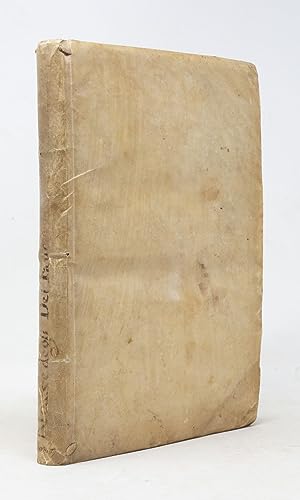
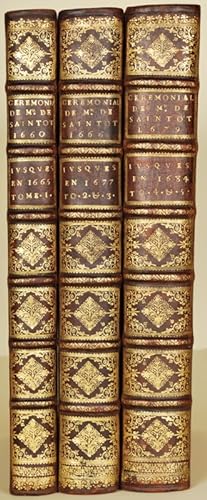
![Image du vendeur pour L'Occhiale all'Occhio. Dioptrica Pratica [.] Dove si tratta della Luce, della Refrattione de raggi, dell'Occhio, della Vista e degli aiuti, che dare si possono à gli occhi per vedere quasi l'impossibile. Dove in oltre si spiegano le regole pratiche di fabbricare Occhiali à tutte le viste, e Cannocchiali da osservare i pianeti, e le stelle fisse, da terra, da mare, et altri da ingrandire migliaia di volte i minimi de gli oggetti vicini mis en vente par SOPHIA RARE BOOKS](https://pictures.abebooks.com/inventory/md/md30574472060.jpg)
